Can You Use Credit Card Statements as Proof for Tax Write-Offs?
The IRS accepts credit card statements as proof of tax write-offs.
Checking credit card statment image by Elzbieta Sekowska from Fotolia.com
The total earnings in your W-2 or business profit-and-loss statement rarely equal your taxable income. The U.S. tax code has provisions that allow you to reduce your tax liability by claiming certain credits and exemptions. You may also qualify to deduct some out-of-pocket expenses from your gross earnings. Keeping good records, such as credit card receipts, for tax purposes is important to prove any reductions in taxable income.
Tip
Taxpayers are able to use credit card statements as proof of the validity of tax write-offs.
Proving Tax Write-offs
Keep with your tax returns documentation that shows any expense you claim as tax-deductible. Acceptable receipts for the IRS include – but are not limited to – cash receipts, bank statements, cancelled checks and pay stubs. When you incur the qualified expense by credit card, the IRS requires a statement that shows the transaction date, the payee’s name and the amount you paid. Do not send receipts with your tax return. File them in case you are audited.
Storing the Proof
The IRS does not care whether you keep your business receipts in a bank’s safe or in an envelope under your bed. Store them in a place that is easy for you to access and organize them in a manner that makes sense to you. At a minimum, file your credit card and other financial documents by tax year. If an IRS auditor comes knocking, you can quickly retrieve your records for the year in question. To streamline your filing system even more, sort the statements by month and expense category.
Retention Period
U.S. tax laws allow the IRS to audit returns for up to three years from the filing date to determine whether you paid the correct taxes. The agency has up to six years to inspect your accounting and require expense proof if it suspects you failed to report 25 percent or more of your income. Furthermore, the Internal Revenue Service is given up to seven years to question taxpayers who claim a loss from a worthless security. In addition, if you make the decision to not file or to file a fraudulent tax return, you expose yourself to the possibility of a federal investigation indefinitely. Thus, at a minimum retain your financial records for three years. To save space, personal finance writer Shelly K. Schwartz recommends you scan your tax forms and save the records electronically.
A Note About Expenses
The range of credit card expenses that qualify as tax deductible is wide. And just because a ream of paper counts to reduce your neighbor’s income, it does not mean you can make the same claim. What you deduct on your taxes depends on your filing status and other variables. If you own a business, for example, the ream of paper is likely to qualify as an office expense that reduces your taxable profit. However, if you print 500 wedding invitations as a favor to your sister, the paper cost does not affect your taxable income. It is valuable to consult an accountant for advice on your specific situation.
References
Writer Bio
Emma Watkins writes on finance, fitness and gardening. Her articles and essays have appeared in "Writer's Digest," "The Writer," "From House to Home," "Big Apple Parent" and other online and print venues. Watkins holds a Master of Arts in psychology.

